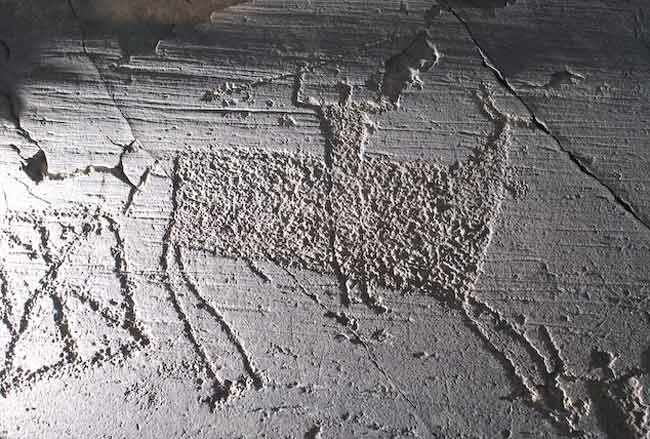Primitive Cinema Used Echoes and Rock Engravings

A Copper Age tribe may have enjoyed a primitive cinematic experience by making stone engravings in an echo-filled Alpine valley, researchers say.
Torchlight and flickering shadows would have made the engravings on stone walls seem to come alive at night. And spoken words that became magnified in a natural outdoor theater could have awakened the storytelling imaginations of observers.
"The past was not just full of bones and broken shards, but it was a sensorial place," said Frederick Baker, an archaeologist at the University of Cambridge in the U.K.
Baker studies the work of the Camuni people, who lived in the central Alps in what is now northern Italy, in a valley known as Val Camonica. They created engravings between 2,500 and 14 B.C., until Roman legionaries under Caesar Augustus swept through and conquered them.
The Camuni engravings stand apart from famous prehistoric cave paintings because they could have been accompanied by the movement of natural light and enhanced sound. The drawings seem to fade out as the midday sun climbs high and then reappear with the setting sun and shadows – an experience that Baker compared to a film dissolve sequence.
The Alpine valley engravings also differ from cave paintings because they sit out in the open for anyone to enjoy the spectacles, according to the researchers.
Sound and vision
Get the world’s most fascinating discoveries delivered straight to your inbox.
To prove that the valley people could have created a soundtrack, Baker and his colleagues tested the echo effect in the valley last September. The researchers invited musicians to play both high and low notes, and the test included Christopher Wells, a well-known Bavarian alphorn and trumpet player.
"If you think of needing the whole valley as an instrument, then it's the alphorn that does it the most in the Alps," Baker told LiveScience. "So we came down, and lo and behold we got amazing echoes at all these locations."
In the experiment, two microphones faced the musician, and two others faced the rock art. One location required special noise filters to screen out the sounds of cars on a nearby highway.
"For our first field recordings, we used a surround-configuration," said Astrid Drechsler, a sound engineer at the St. Pölten University of Applied Sciences in Austria. "During these first recordings the main focal point was on catching the atmosphere and spirit at these places."
Drechsler's sound team plans to record both loud and very short sounds next September, and try to discover more about the delay time, sound intensity and acoustic spectrum of the echoes.
Pictures not yet rated
The Camuni's stone engravings include everything from shaman-like mystical figures to purely geometric forms such as mazes. Other scenes show dueling, hunting, houses and dancing people.
But some subjects remained taboo or marginalized. Women rarely appear, even if a few transgendered figures appear. The engravings also stay away from the subject of death.
"You see weapons, you see dueling, and you see people on horses with weapons," Baker noted. "But you never see a deer with an arrow through it, or a person being stabbed."
That suggests the Camuni did not want to show the moment of death or killing, despite having and using weapons, Baker said.
Each generation of engravers also seems to have respected the pictures that came before, because rarely do any images overlap.
Respect for past storytellers
Baker wants to give these pictures a wider audience.
"The first thing I thought was we can animate these," Baker said. "We could make these [engravings] move."
His epiphany about primitive cinema struck him when he first saw the engravings with Christopher Chippindale, a rock art specialist at the University of Cambridge.
That led to the creation of the Prehistoric Picture Project, a collaboration between St. Pölten University of Applied Sciences, the University of Cambridge and the Bauhaus-Universitat Weimar in Germany.
In his work on the project, Baker draws upon not only his archaeological training, but also his filmmaking experience that includes making films for the Cannes Film festival and the BBC. He has already begun putting together an animated film that brings some of the engravings to life, so to speak.
"I'm not saying these rocks are exactly cinema-like or in that form, because obviously the images don't move," Baker explained. "I'm saying these images in these locations are the closest the people would have had to a visual-acoustic experience, i.e. a cinematic experience."
- Gallery: The Seven Ancient Wonders of the World
- History's Most Overlooked Mysteries
- Top 10 Ancient Capitals



